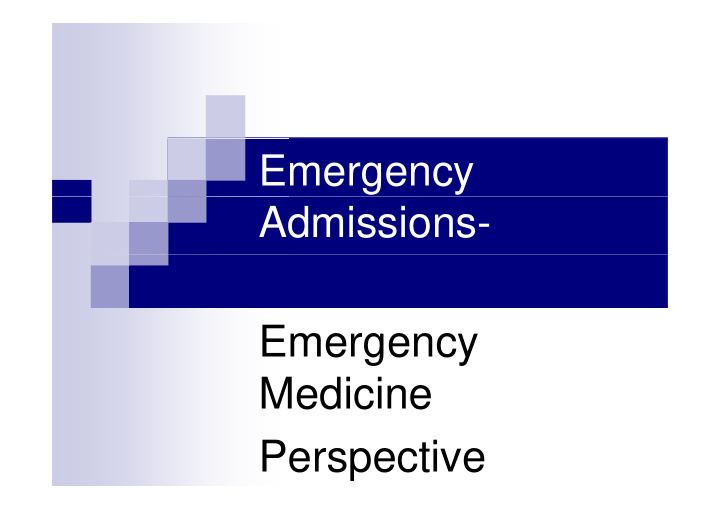



Emergency Admissions- Emergency Medicine Perspective
Casualty or A&E or Casualty or A&E or Emergency Medicine g y
� Size of the service Size of the service � Increase in Admissions � 4 hour target � Review of relevant recommendations in � Review of relevant recommendations in the report
High volume � Almost 3 million emergency � Almost 3 million emergency admissions each year y � Increase of 750,000 over , the past five years.
Patients per year per population of 250,000 people A&E A&E attendances tt d 60 000 (12 000 60,000 (12,000 admit) d it) Emergency Admissions (all sources) 22,000 G General Medicine l M di i 6 000 6,000 Other Medical specialties 3,000 S Surgery 2 200 2,200 Orthopaedics 1,300 Gynaecology 900 Plastic/chest/maxillo-facial surgery 400 Adult mental health 300 MI requiring thrombolysis or PCI 60 Major trauma 50
Admitting specialties � General Medicine � General Medicine � General Surgery General Surgery � Orthopaedics � Others
Why increase? Why increase? ( Our future health secured? -Kings Fund) ( g ) � Chest pain
Increase (King’s Fund) � Elderly- chest pain SOB Abdominal pain Abdominal pain Pneumonia U i Urinary Tract Infection T t I f ti Syncope y p
Quality- 4 hour target � Generally good for patients � Generally good for ED staff � Focus on admission systems � Focus on admission systems � Led to creation of EAUs � Active management of flows
4 hour target- downside � Some patients need longer � Pressure on ED staff � Danger of patients becoming part of � Danger of patients becoming part of process rather than individuals
NCEPOD Quality � Majority good � Significant minority could be better � Worrying 7% “less than satisfactory” y g y
Recommendation seniority of Recommendation-seniority of doctor � 3 million admissions � 700 Emergency medicine consultants � 50% departments have 24 hour � 50% departments have 24 hour senior/middle grade cover
College of EM- policy � By 2012 every ED should have 24 hour senior/middle grade presence in the ED the ED � (By 2012 2000 fully trained EM doctors)
Documentation � A confession
Training/support � Effects of MMC � 4 monthly rotations � Many more junior doctors � Many more junior doctors � Excellent training environment � Good supervision in some departments Good supervision in some departments � Challenges in small departments g p
24 hour CT � CEM policy for many years � Worrying that 15% no access to CT � Worrying that 15% no access to CT � Impossible to deliver high quality Emergency Care without immediate CT Emergency Care without immediate CT access
Transfers � Challenges of reorganisation of services � Challenges of tertiary centres � Transfer critical care under developed � Transfer critical care under-developed
Concept of Shared Care � Hard concept to get across to admitting specialties � A minority of patients need input from � A minority of patients need input from more than one specialty
Handover � Clinician to clinician � Immediacy � Documentation � Documentation
Unnecessary Admissions � 6%, even in this “serious” cohort, might be inappropriate � Questions of end of life care � Questions of end of life care. � Lack of good care plans � Lack of immediate community support for critical events in process of plans critical events in process of plans
Summary � College of Emergency Medicine welcomes this report � Strongly support the involvement of senior � Strongly support the involvement of senior staff in care of very ill patients � Committed to working with other C itt d t ki ith th specialties to improve care
Recommend
More recommend